Nissan Rogue (T33) 2021-Present OwnerŌĆÖs Manual & User Guide: Forward-facing child restraint installation using the seat belts
Basic information
WARNING
The three-point seat belt with ALR mode must be used when installing a child restraint. Not using ALR will result in an unsecured restraint, increasing injury risk during sudden stops or collisions.
Review all Warnings and Cautions in the ŌĆ£Child safetyŌĆØ and ŌĆ£Child restraintsŌĆØ sections before installation.
Do not use the lower anchors if the combined weight of child + restraint exceeds 65 lbs (29.5 kg). Install with the Nissan Rogue seat belt instead. Follow the restraint manufacturerŌĆÖs instructions.
Steps to install a forward-facing restraint using the seat belt in the rear seat or front passenger seat:
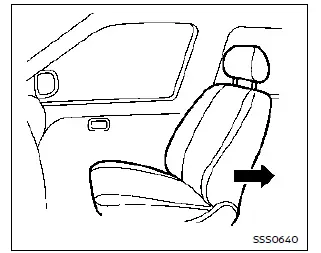
Forward-facing (front passenger seat) - step 1
1. If installing a child restraint in the front seat, it must be forward-facing only. Move the seat to the rearmost position.
Rear-facing restraints for infants must never be used in the front passenger seat.
2. Position the child restraint on the seat and follow the manufacturerŌĆÖs instructions.
Ensure the back of the child restraint is firmly against the Nissan Rogue seatback.
Adjust or remove the head restraint/headrest if necessary. Store properly and reinstall after removing the child restraint. See ŌĆ£Head restraints/headrests.ŌĆØ
If the seating position has a fixed headrest that interferes, use a different seat or another child restraint model.

Forward-facing - step 3
3. Route the seat belt through the restraint as instructed and buckle until the latch engages.
If equipped with a top tether, attach the tether strap to the appropriate tether anchor (rear seat only). Do not install tether-required restraints in seating positions without a tether anchor.
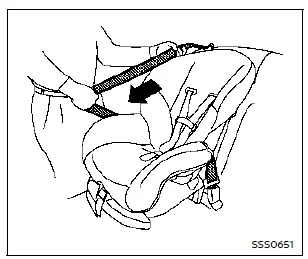
Forward-facing - step 4
4. Pull the shoulder belt until it is fully extended. At this moment, the retractor in your Nissan Rogue switches to Automatic Locking Retractor (ALR) mode, intended for securing child restraints. When the belt fully retracts, it returns to Emergency Locking Retractor (ELR) mode.
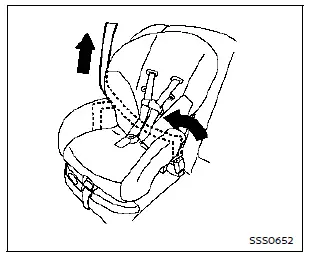
Forward-facing - step 5
5. Allow the seat belt to retract, then pull upward on the shoulder belt to remove slack.
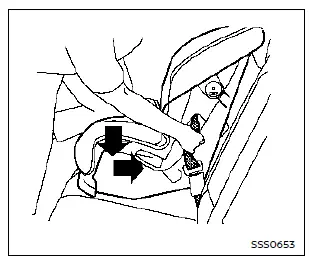
Forward-facing - step 6
6. Remove remaining slack by pressing downward and rearward firmly in the center of the child restraint with your knee, compressing the Nissan Rogue seat cushion and seatback while tightening the belt.
7. Tighten the tether strap according to the manufacturer's instructions.

Forward-facing - step 8
8. Test the installation before placing the child inside. Hold the restraint near the belt path and push it side-to-side.
The restraint should not move more than 1 inch (25 mm). Pull forward to confirm the belt holds securely. If movement exceeds 1 inch, tighten the belt or reinstall the restraint in another seating position of your Nissan Rogue. Not all child restraints fit all vehicles.
9. Ensure the restraint remains properly secured before each use. If the seat belt is not locked, repeat steps 2 through 8.
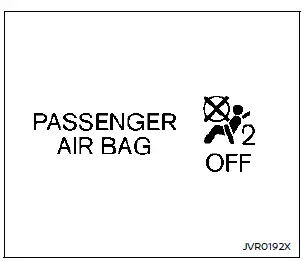
Forward-facing - step 10
10. If the restraint is installed in the front passenger seat, place the ignition switch in the ON position. The front passenger air bag status light
 should illuminate. If it does not, see ŌĆ£Front passenger air bag and status light,ŌĆØ then move the restraint to another seating position and have the system inspected. Visiting a NISSAN dealer is recommended.
should illuminate. If it does not, see ŌĆ£Front passenger air bag and status light,ŌĆØ then move the restraint to another seating position and have the system inspected. Visiting a NISSAN dealer is recommended.
After the child restraint is removed and the seat belt fully retracts, ALR mode is cancelled.

 Installing top tether strap
Installing top tether strap
WARNING
Child restraint anchorages are designed only for loads from correctly installed child restraints. Never attach adult belts or other equipment to them. Damage could compromise safety and l ...
 Installing top tether strap
Installing top tether strap
WARNING
Child restraint anchorages are designed only for correctly installed restraints. Never attach adult seat belts or other equipment to these pointsŌĆödoing so may damage the anchors and com ...
Other materials:
Wiring diagram
ENGINE CONTROL SYSTEM
Wiring Diagram
...
Troubleshooting guide
Verify the location of all Intelligent Keys that are
programmed for the vehicle. If another Intelligent
Key is in range or inside the vehicle, the vehicle
system may respond differently than expected.
Symptom
Possible Cause
Remedy
When stopping the engine
The Shift to Pa ...
Approach warning
Approach warning
NOTE:
The warning chime may sound and the FCW
indicator may blink when the distance sensor
detects vehicles in other lanes A or
objects on the side of the road A . This may
cause the FCW system to operate inappropriately.
The distance sensor may detect
these objects wh ...
